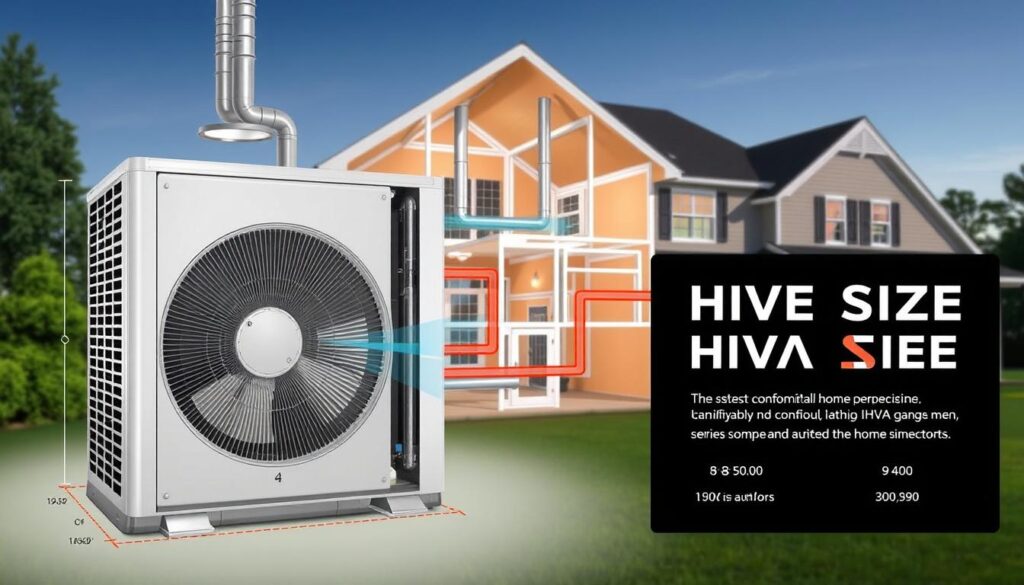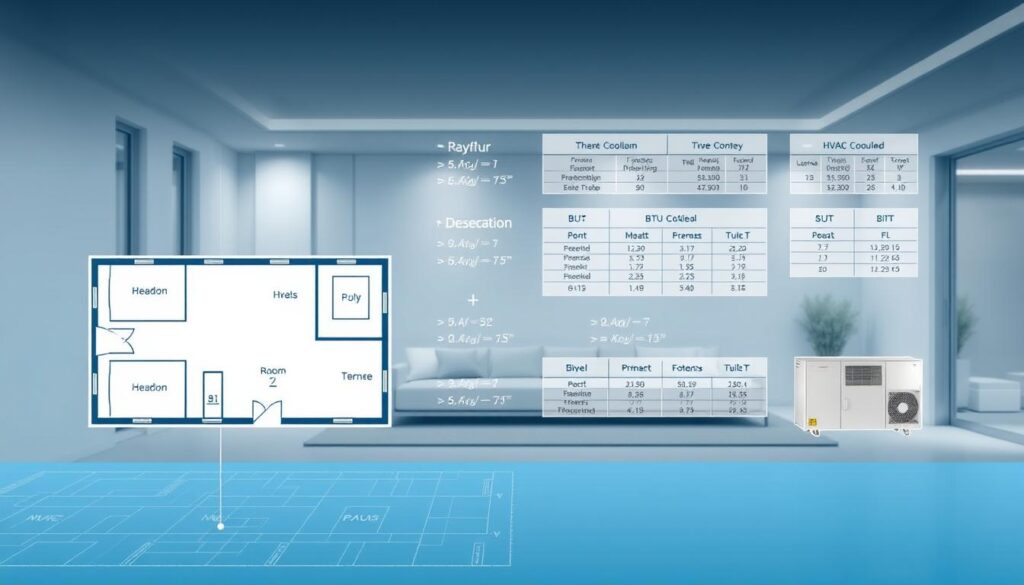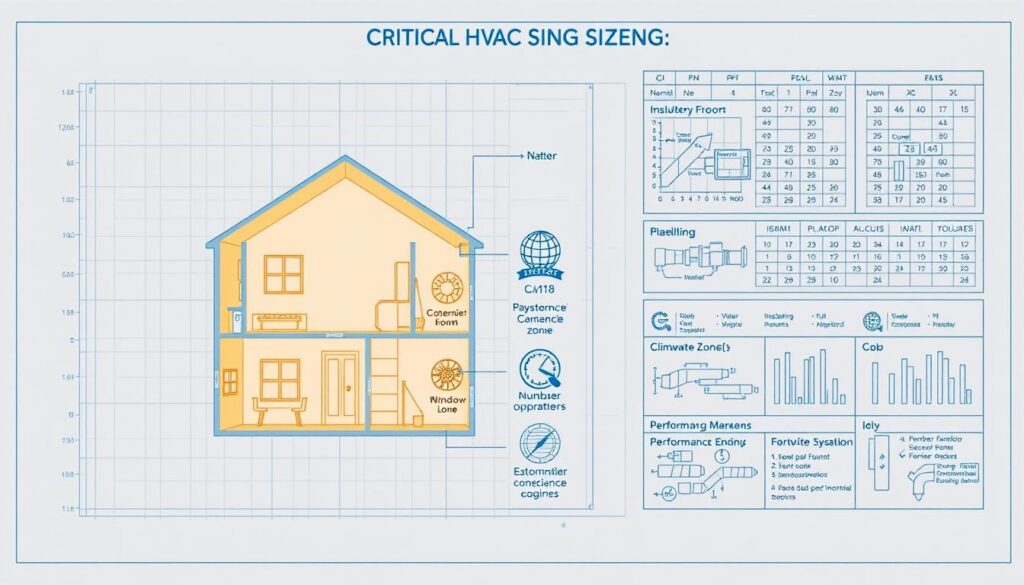Affiliate Disclosure
HVAC Guide Guys is a participant in the Amazon Services LLC Associates Program, an affiliate advertising program designed to provide a means for sites to earn advertising fees by advertising and linking to Amazon.
How Much HVAC Do I Need for Home Air Conditioning? Are you tired of rooms that feel like a sauna or an arctic tundra? Finding the right HVAC for your home is more than a technical task. It’s about making your home the perfect comfort zone.

Choosing the right HVAC system is key to comfortable living. It affects your home’s temperature, energy bills, and overall comfort. Figuring out how much HVAC you need involves looking at several factors.
Your home’s unique features are important in picking the right cooling solution. Square footage and local climate are just a few things to consider. Every detail counts when finding the perfect HVAC for your home.
Key Takeaways
- Proper HVAC sizing ensures optimal home comfort
- Oversized or undersized units can lead to inefficient cooling
- Multiple factors influence HVAC system selection
- Professional assessment helps determine exact cooling requirements
- Energy efficiency directly relates to correct HVAC sizing
Table of Contents
Understanding HVAC System Basics
When you think about residential hvac sizing, it’s key to know the basics. You need to understand the parts and types of cooling systems for homes. The right HVAC system depends on your home’s needs and the local climate.
Today’s home air conditioning systems come in a few main types. Each is made to tackle different cooling needs. Your choice affects comfort, energy use, and costs over time.
Types of HVAC Systems
- Split-System Units: Most common in homes, with parts inside and outside
- Ductless Mini-Split Systems: Great for homes without ducts
- Packaged HVAC Units: Perfect for small spaces or unique designs
Key Components of Home Air Conditioning
Every HVAC system has important parts that work together. They control the temperature and air quality inside. Knowing these parts helps you choose the right size for your home.
- Compressor: Moves refrigerant and cools
- Condenser Coil: Gets rid of heat from the refrigerant
- Evaporator Coil: Takes in indoor heat
- Air Handler: Spreads cooled air around your home
The Importance of Proper HVAC Sizing
Choosing the right HVAC size is vital. A system that’s too big or too small can waste energy and damage equipment. A professional can help find the perfect size for your home’s comfort and efficiency.
Proper HVAC sizing is not just about square footage—it’s about creating a comfortable, energy-efficient living environment.
How Much HVAC Do I Need
Finding the right HVAC size for your home is key for comfort and saving energy. It’s not just about picking a system that fits everyone. Your home’s special features are important in choosing the best HVAC.
- Home square footage
- Local climate conditions
- Home insulation quality
- Number of windows and their orientation
- Ceiling height
- Home layout and room configuration
Experts use a detailed method to figure out the exact HVAC size your home needs. This way, you avoid a system that’s too big or too small, saving energy and keeping you comfortable.
| Home Size (sq. ft.) | Approximate HVAC Capacity | Energy Efficiency Range |
|---|---|---|
| 1,000-1,500 | 2-3 tons | 14-16 SEER |
| 1,500-2,000 | 3-4 tons | 16-18 SEER |
| 2,000-2,500 | 4-5 tons | 18-20 SEER |
Knowing what HVAC size you need helps you choose wisely. It’s about finding a balance between comfort, performance, and saving energy. The right system will cool your home well and cut down on energy bills.
Explore Our HVAC Shop
Looking for top-rated HVAC tools, parts, and accessories? Visit our shop and find the perfect solution for your needs.
Visit the ShopCalculate Your Home’s Square Footage for HVAC Sizing
Getting your home’s square footage right is key for good HVAC sizing. Knowing your living space well ensures your heating and cooling work well. The right size can save energy, cut down on bills, and keep your home comfy.
Measuring your home’s size needs careful attention. Accurate room measurements are vital for proper hvac load calculation.
Measuring Individual Room Dimensions
To measure rooms well, you’ll need a few tools:
- Measuring tape or laser distance measurer
- Notepad and pencil
- Calculator
Total Square Footage Calculation Method
Here’s how to figure out room square footage:
- Measure the length of each room
- Measure the width of each room
- Multiply length by width
- Record the square footage for each room
- Add all room measurements together
Multi-Story Home Considerations
For homes with more than one floor, calculate each floor’s square footage. Heating and cooling needs vary between levels because of sun exposure, insulation, and how rooms are used.
Pro tip: Remember, not all square footage is the same. Rooms with high ceilings, big windows, or lots of sunlight might need more cooling.
BTU Requirements Based on Home Size
Knowing your home’s HVAC capacity is key to keeping it cool. The HVAC BTU calculator helps figure out the right cooling for your space. A common guideline is about 20 BTUs per square foot of living area.

BTUs measure the energy needed to cool or heat a space. Your home’s size and features affect the BTU needs more than just square footage.
| Home Size (sq ft) | Recommended BTUs | Typical Room Coverage |
|---|---|---|
| 500-700 | 10,000 | Small Apartment |
| 1,000-1,200 | 20,000 | Medium Apartment/Small Home |
| 2,000-2,500 | 40,000 | Large Home |
Several factors affect your home’s HVAC capacity needs:
- Ceiling height
- Insulation quality
- Number of windows
- Local climate conditions
- Home orientation
Professional HVAC technicians suggest a detailed assessment for accurate BTU calculations. This ensures the best cooling efficiency.
Explore Our HVAC Shop
Looking for top-rated HVAC tools, parts, and accessories? Visit our shop and find the perfect solution for your needs.
Visit the ShopUnderstanding SEER Ratings and Energy Efficiency
Choosing the right HVAC system means looking at energy efficiency. SEER (Seasonal Energy Efficiency Ratio) ratings are key to knowing how well your system works and how much it will cost over time.
SEER ratings show how well your air conditioner uses electricity to cool your home. The higher the SEER rating, the better your system’s energy use. Today’s HVAC systems aim for high SEER ratings to cut down on energy use and lower bills.
What SEER Ratings Reveal
SEER ratings go from 13 to 26, each with its own effect on your home’s comfort and energy costs. Here’s what each range means:
- 13-14 SEER: Minimum efficiency standard
- 15-16 SEER: Good energy performance
- 17-20 SEER: High efficiency
- 21-26 SEER: Premium energy savings
Optimal SEER Ratings for Different Climates
Your area’s climate affects the best SEER rating for your HVAC needs. Places like Arizona or Florida need higher SEER ratings (18-26) for big energy savings. Cooler areas might do well with ratings between 14-16.
Remember, choosing a higher SEER rating can save you money in the long run. It means using less energy and paying less for utilities.
Factors Affecting HVAC Size Requirements

Finding the right HVAC size for your home is not just about measuring square footage. Many important factors affect your heating and cooling needs. This makes figuring out the right HVAC size a complex task.
Your home’s unique features greatly influence the size of your HVAC system. Here are the main elements that affect your system’s needs:
- Climate Conditions: Local temperature and humidity levels greatly impact HVAC sizing needs
- Home Insulation Quality: Better insulation means less work for your HVAC system
- Window Configuration: The number, size, and type of windows affect heat transfer
- Ceiling Height: Taller rooms need more cooling and heating
- Home Orientation: The direction your home faces affects solar heat gain
Personal lifestyle choices also affect HVAC load calculation. The number of people living in your home, how much you cook, and your daily activities can change your heating and cooling needs.
Professional HVAC technicians use advanced calculations to find the exact system size for comfort and efficiency.
Knowing these factors helps you make smart choices about your home’s HVAC system. It ensures you have comfortable temperatures and saves energy.
Explore Our HVAC Shop
Looking for top-rated HVAC tools, parts, and accessories? Visit our shop and find the perfect solution for your needs.
Visit the ShopManual J Load Calculation Explained
Getting the right HVAC size for your home is more than just measuring it. The Manual J load calculation is the top choice for accurate HVAC system checks. It makes sure your home gets the best cooling and heating.
The Manual J load calculation looks at many important factors for your home’s temperature control. It’s not just about the square footage. This detailed method gives a clear picture of what your home needs for cooling and heating.
Professional Assessment Components
A detailed hvac load calculation checks several key things:
- Home square footage and layout
- Insulation quality and type
- Window size, quantity, and orientation
- Local climate conditions
- Number of occupants
- Household heat-generating appliances
Why Manual J is Important
Choosing the right HVAC system is about more than comfort. It’s about saving money and being efficient. The wrong size can cause:
- Higher energy bills
- Inconsistent temperature control
- Increased wear and tear on equipment
- Reduced system lifespan
Professional HVAC contractors use Manual J to find the exact cooling and heating your home needs. This avoids both too small and too big systems. It ensures your system works well and saves energy.
| Calculation Factor | Impact on HVAC Sizing |
|---|---|
| Home Insulation | Directly influences heat retention and cooling needs |
| Window Efficiency | Affects heat transfer and required cooling capacity |
| Local Climate | Determines baseline temperature management requirements |
Getting a professional Manual J load calculation can save you a lot of money. It also keeps your home comfortable all year.
Common HVAC Sizing Mistakes to Avoid
Homeowners often make big mistakes when sizing their HVAC systems. These errors can lead to expensive and uncomfortable cooling issues. Knowing these common mistakes can help you avoid them.
Choosing the right HVAC system is more than just calculating square footage. Many people fall into traps that lead to inefficient cooling and higher energy costs.
- Relying exclusively on square footage measurements
- Ignoring local climate and humidity levels
- Assuming larger units automatically mean better cooling
- Skipping professional load calculations
One big mistake is choosing an oversized unit. It might seem like a bigger system cools faster. But, it actually causes many problems.
- Increases energy consumption
- Creates uneven temperature distribution
- Reduces overall system efficiency
- Leads to premature equipment wear
Professional HVAC contractors use Manual J load calculations to determine the precise cooling requirements for your home. This detailed assessment looks at more than just square footage. It considers:
- Insulation quality
- Window types and orientation
- Local climate conditions
- Number of occupants
- Heat-generating appliances
Spending time on proper hvac sizing can help you achieve optimal cooling. It also keeps your energy costs down and your home comfortable.
Cost Considerations for Different HVAC Sizes
When planning your hvac installation guide, it’s key to understand the cost of different sizes. Your initial cost isn’t just the price tag. It also includes long-term expenses and energy use.
The right HVAC size affects your home’s comfort and your budget. Bigger units cost more upfront but might not be the best for every home.
- Small systems: Lower initial cost, but might not be efficient
- Medium systems: Good balance of cost and performance
- Large systems: Higher cost upfront, but could save on energy
Choosing the right size is vital for getting the most from your HVAC. The wrong size can cause:
- More energy use
- Higher bills
- Shorter system life
- Uneven temperatures
“Investing in the right-sized HVAC system is like buying a perfectly tailored suit – it fits just right and performs exceptionally.” – HVAC Professional
Professional HVAC contractors can find the most cost-effective solution for your home. They consider your home’s size, insulation, and local weather.
Explore Our HVAC Shop
Looking for top-rated HVAC tools, parts, and accessories? Visit our shop and find the perfect solution for your needs.
Visit the ShopClimate Zone Impact on HVAC Requirements
Your home’s location is key in choosing the right HVAC capacity. Different climate zones across the United States affect cooling needs. It’s important to know how regional temperatures impact your HVAC system choice.
The United States has several climate zones, each with its own temperature and humidity. These zones affect the HVAC capacity needed for your home’s cooling. For example:
- Southern regions like Florida and Texas need higher cooling capacities because of the extreme heat.
- Coastal areas require systems that can control humidity.
- Northern states need versatile HVAC systems for both heating and cooling.
When looking at your home’s cooling needs, consider these climate zone factors:
- Average summer temperatures
- Humidity levels
- Temperature changes
- Season length
Professional HVAC contractors use special tools to find the exact system you need. They consider your climate zone. This ensures you get a system that fits your home’s cooling needs well.
Selecting the right HVAC capacity isn’t just about comfort—it’s about energy efficiency and long-term cost savings.
Conclusion
Figuring out how much HVAC you need is important. It affects your home’s comfort and energy use. Getting a professional to do a Manual J load calculation is the best way to size your HVAC.
Think about your home’s size, the local weather, insulation, and layout when choosing your HVAC. The right size is key to avoid high energy bills and discomfort. A system that’s too big or too small can cause problems.
Use a guide for HVAC installation that includes a professional evaluation. Experts can help you choose the right system for your home. They consider BTU needs, SEER ratings, and your home’s specifics to ensure efficiency and performance.
Do your homework and talk to HVAC experts for advice. They can give you a plan that makes your home comfortable and saves energy. This way, you’ll have a reliable system for years to come.

